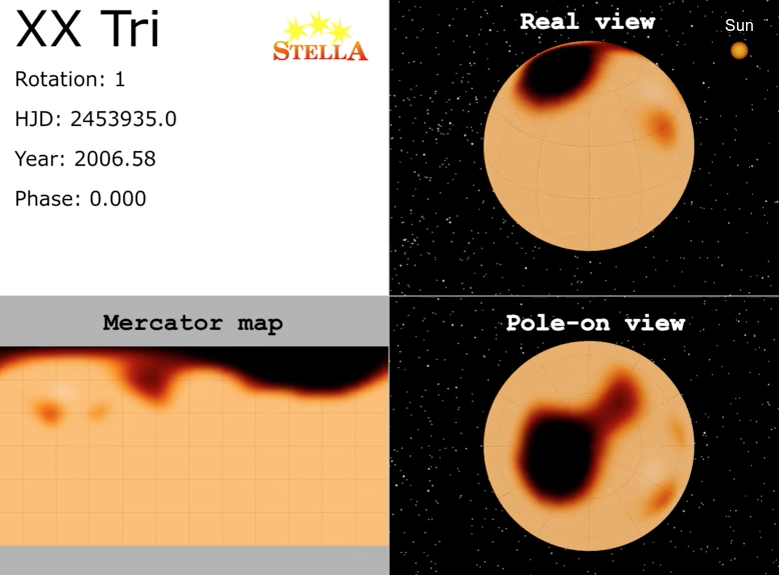Still from movie. Credit: A. Künstler, T. A. Carroll, and K. G. Strassmeier, Leibniz Institute for Astrophysics Potsdam (AIP)
Astronomers from the Leibniz Institute for Astrophysics Potsdam (AIP), present for the first time a movie that shows the evolution of stellar spots on a star other than our Sun. The long-term, highly-sampled, phase-resolved spectroscopic data were made possible with the STELLA robotic telescopes on Tenerife. Over a period of 6 years the growth and fade of giant stellar spots on the star XX Tri are seen. The spots reveal an underlying magnetic cycle that has a period comparable to our Sun's but is much stronger.
Generally, it is not possible to resolve stellar surfaces other than our Sun's directly. Clever mathematical methods and observing techniques were introduced to resolve stellar surfaces indirectly. This technique, commonly referred to as Doppler imaging or Doppler tomography, became the most advanced tool for the study of stars. In order to not only image but also to reconstruct the evolution of star spots, well-sampled time series of high-resolution spectra are needed. To obtain one single image of the stellar surface, intrinsic variations confine the data gathering process to basically a single stellar rotation.
Such long-term, highly-sampled, phase-resolved spectroscopic data for Doppler imaging of the red giant star XX Tri presented here were made possible with the STELLA robotic telescopes on Tenerife over an observing period of 6 years and are continued. This star is famous for its detected super-spot with a linear extension of 12 × 20 solar radii (Strassmeier 1999). But even for a star like XX Tri with a rotation period of 24 days, this was not a simple task. Sampling the evolution of the star spots required nightly visits of the target to obtain a continuous decade-long time series of spectra.
Altogether 667 usable spectra between July 2006 and April 2012 were inverted into a movie of the stellar surface, which cover altogether 86 rotational periods of the star. Shown is the stellar surface in three different projection styles; a spherical projection like if we would see the star by eye ("real view"), a Mercator projection where the entire surface can be seen at once ("Mercator map"), and a "pole-on view" like if the star could be viewed down onto the one visible rotation pole. Note the size of the Sun in the real-view panel, it is to scale.
This unique time-series of Doppler images shows that the surface of the star XX Tri is covered with large high-latitude and even polar spots and with occasional small equatorial spots. Just over the course of six years, a systematically changing spot distribution and morphology such as spot fragmentation and spot merging as well as spot decay and formation is seen. Credit: A. Künstler, T. A. Carroll, and K. G. Strassmeier, Leibniz Institute for Astrophysics Potsdam (AIP)
The movie shows a star-spot distribution with ever changing morphology, such as spot fragmentation and spot merging, and with apparently a large range of variability timescales. The decay rate of (magnetic) star spots is of great interest as it is directly related to the magnetic diffusivity in the convective layer of the star, which itself is a key quantity for the length of a magnetic-activity cycle. "We can see our first application as a prototype for upcoming stellar cycle studies, as it enables the prediction of a magnetic-activity cycle on a dramatically shorter timescale than usual," says Andreas Künstler, who worked on XX Tri during his PhD at Leibniz Institute for Astrophysics Potsdam (AIP).
Sunspots are understood as the emergence of magnetic flux tubes originating from a dynamo process in the interior. As sunspots host strong magnetic fields, their study provides indirect information about the internal dynamo activity.
Close Up: real-view animation. Credit: A. Künstler, T. A. Carroll, and K. G. Strassmeier, Leibniz Institute for Astrophysics Potsdam (AIP)
STELLA, short for "STELLar Activity", is two fully robotic 1.2m telescopes at the Teide Observatory in Tenerife, Spain, jointly operated by AIP and IAC. They uniquely combine a high-resolution spectrograph and a wide-field photometric imager. No personnel are on site. STELLA was built at AIP and is a long-term project for observing and monitoring activity tracers on cool stars.
Provided by Leibniz Institute for Astrophysics Potsdam
























